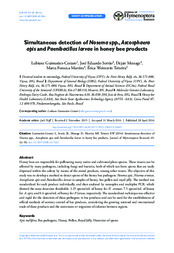Simultaneous detection of Nosema spp., Ascosphaera apis and Paenibacillus larvae in honey bee products.
Simultaneous detection of Nosema spp., Ascosphaera apis and Paenibacillus larvae in honey bee products.
Author(s): GUIMARÃES-CESTARO, L.; SERRÃO, J. E.; MESSAGE, D.; MARTINS, M. F.; TEIXEIRA, É. W.
Summary: Abstract Honey bees are responsible for pollinating many native and cultivated plant species. These insects can be affected by many pathogens, including fungi and bacteria, both of which can form spores that are easily dispersed within the colony by means of the stored products, among other routes. The objective of this study was to develop a method to detect spores of the honey bee pathogens Nosema apis, Nosema ceranae, Ascosphaera apis and Paenibacillus larvae in samples of honey, bee pollen and royal jelly. The method was standardized for each product individually, and then analyzed by monoplex and multiplex PCR, which showed the same detection thresholds: 1.25 spores/mL of honey for N. ceranae; 7.5 spores/mL of honey for A. apis; and 0.4 spore/mL of honey for P. larvae, respectively. The standardized technique was effective and rapid for the detection of these pathogens in bee products and can be used for the establishment of official methods of sanitary control of bee products, considering the growing national and international trade of these products and the movement or migration of colonies between regions.
Publication year: 2016
Types of publication: Journal article
Unit: Embrapa Dairy Cattle
Keywords: Apis Mellifera, Bee pathogens, Detection of spores, honey, pollen, royal jelly
Observation
Some of Embrapa's publications are published as ePub files. To read them, use or download one of the following free software options to your computer or mobile device. Android: Google Play Books; IOS: iBooks; Windows and Linux: Calibre.
Access other publications
Access the Agricultural Research Database (BDPA) to consult Embrapa's full library collection and records.
Visit Embrapa Bookstore to purchase books and other publications sold by Embrapa.

